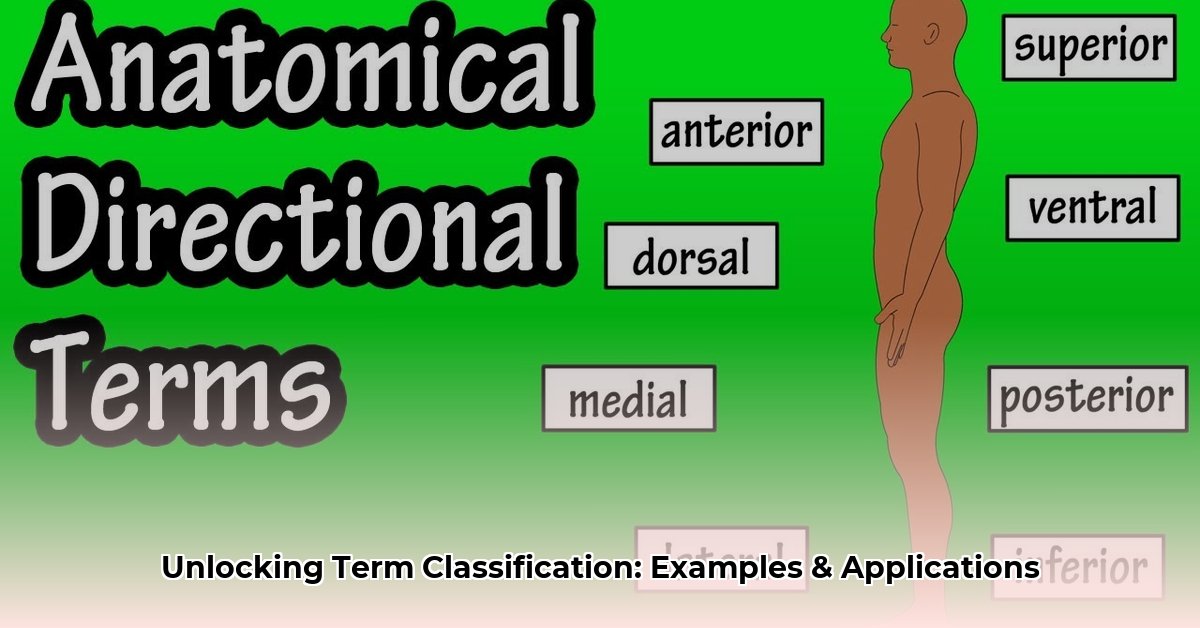Understanding Classification
Ever feel overwhelmed by information overload? Classification is your brain’s way of creating order from chaos. Just like organizing a messy room, it involves sorting items based on shared characteristics. This guide provides a practical toolkit for mastering classification, from simple everyday tasks to complex data analysis.
What is Classification?
Classification is the process of grouping things based on shared characteristics. Think sorting Lego bricks: you’d likely group similar shapes and colors together. This principle applies to everything from groceries to scientific data. It helps us make sense of the world by creating mental “filing cabinets” for information.
Basic Principles of Classification
Effective classification relies on a few key principles:
- Clear Criteria: Establish consistent rules for grouping items. Stick to these rules! Don’t put a blue brick in the red pile just because you’re out of blue bricks.
- Relationships Between Groups: Consider how groups relate. Your “red brick” pile might belong to a larger “rectangular brick” group, creating a hierarchical structure.
- Flexibility: Classification is dynamic. Be prepared to adapt your system as new information emerges or your needs change.
Classification in Biology: Taxonomy
Biology provides a powerful example of classification in action. Scientists use taxonomy to organize the vast diversity of life on Earth. It’s a hierarchical system, starting with broad kingdoms (animals, plants, fungi, etc.) and narrowing down to individual species. This “tree of life” reveals evolutionary relationships between organisms. For example, humans (Homo sapiens) belong to the Animal Kingdom, Mammal Class, Primate Order, and so on. When a new species is discovered, scientists meticulously analyze its features and DNA to determine its place within this intricate framework.
Real-World Applications
Imagine you’re a researcher studying a new ant species. You’d examine its anatomy, behavior, and genetics to classify it within the existing taxonomic framework. This involves matching the ant’s characteristics (the “given terms or examples”) with the appropriate category (species, genus, family, etc.). Here’s a simplified table illustrating how some biological kingdoms are classified:
| Kingdom | Key Features | Example |
|---|---|---|
| Animalia | Multi-cellular, heterotrophic, motile | Lions, butterflies |
| Plantae | Multi-cellular, autotrophic, cell walls | Trees, flowers |
| Fungi | Multi-cellular, absorptive nutrition, cell walls | Mushrooms, yeast |
| Protista | Mostly single-celled, complex cells | Amoebas, algae |
| Monera/Bacteria | Single-celled, simpler cells | Bacteria, archaea |
Classification extends far beyond biology. Libraries use the Dewey Decimal System to organize books. Programmers structure data using classification principles. We organize our clothes by type—shirts, pants, socks. It’s a fundamental tool for managing information in countless contexts.
Mastering Classification: Advanced Techniques
Mastering classification goes beyond simple sorting. It involves understanding nuances, choosing appropriate methods, and recognizing potential pitfalls. This section explores advanced classification techniques and strategies.
Different Classification Approaches
Just as there are many ways to organize a closet, there are various classification approaches. Here are a few prominent ones:
- Conceptual Classification: Grouping items based on underlying concepts. “Renewable energy” and “fossil fuels” are both energy sources, but conceptually different.
- Functional Classification: Grouping items based on their purpose or function. Tools in a toolbox are classified by their function (hammer, screwdriver, wrench).
- Hierarchical Classification: Creating nested categories and subcategories, as seen in biological taxonomy.
A Step-by-Step Guide to Effective Classification
-
Identify Key Characteristics: Analyze items to identify shared features and differences.
-
Group Similar Items: Group items based on shared traits. Be prepared to refine your groupings as you go.
-
Create Subcategories (If Needed): For complex sets, break down broad categories into more specific subcategories.
-
Maintain and Update: Regularly review and update your classification system to ensure accuracy and relevance.
Practical Examples
Classification is everywhere! E-commerce websites use it to organize product catalogs. Libraries rely on the Dewey Decimal System. Scientists use taxonomy to understand the interconnectedness of life on Earth.
Challenges in Classification
Classification isn’t always easy. Here are some common challenges:
- Overlapping Categories: Some items may fit into multiple categories.
- Vague Criteria: Difficulty defining clear, consistent criteria for classification.
- Context Dependence: A system that works well in one context may not be suitable for another.
Why is Classification Important?
Classification is a crucial skill for navigating our information-saturated world. It helps us:
- Manage Information Overload: Organize the constant influx of data from various sources.
- Structure Our Thinking: Clarify thoughts and ideas, facilitating better communication and problem-solving.
- Enhance Learning: Connect new information with existing knowledge, improving recall and application.
- Improve Decision-Making: Analyze options systematically, leading to more informed choices.
- Facilitate Communication: Ensure clear communication and collaboration through shared understanding of categories.
Classification Strategies
Here are some common classification strategies:
| Method | Description | Example |
|---|---|---|
| Hierarchical | Tree-like structure with broad categories branching into subcategories. | Biological taxonomy |
| Taxonomic | Based on shared characteristics, often used in biology. | Classifying organisms |
| Conceptual | Based on shared ideas or meanings. | Grouping books by genre |
| Sequential | Arranged in a specific order (alphabetical, chronological, etc.). | Organizing files by date modified |
| Spatial | Based on physical location. | Arranging furniture |
| Chronological | Based on time or sequence of events. | Historical timelines |
The best strategy depends on your specific needs. Experiment and find what works best for you!
Methods of Classification in Machine Learning
Machine learning uses algorithms to classify data, mimicking human categorization abilities. This section explores various methods used in machine learning classification.
Binary Classification
Binary classification sorts data into two distinct groups. Examples include spam detection (spam or not spam) and fraud detection (fraudulent or legitimate). Algorithms like Logistic Regression and Support Vector Machines are commonly used in this approach.
Multi-Class Classification
Multi-class classification handles more than two categories. Think image recognition (identifying different objects in a picture) or medical diagnosis (classifying diseases based on symptoms). Algorithms like Multinomial Logistic Regression, Decision Trees, and K-Nearest Neighbors are suitable for this task.
Multi-Label Classification
Multi-label classification allows items to belong to multiple categories simultaneously. Tagging pictures on social media is an example. One picture might have multiple tags (family, vacation, beach). Techniques like problem transformation methods are employed for this type of classification.
Other Classification Approaches
Beyond machine learning, there are other classification methods like chronological (sorting by date), qualitative (sorting by quality), quantitative (sorting by numerical value), and geographical (sorting by location). These methods offer valuable perspectives on organizing information.
Building a Classification Model
Here’s a simplified process for building a machine learning classification model:
-
Data Collection: Gather a large, labeled dataset relevant to your problem.
-
Feature Extraction: Select the most relevant features (characteristics) from your data.
-
Model Training: Train your chosen algorithm using the labeled data.
-
Model Evaluation: Test the model’s performance on unseen data to assess its accuracy.
-
Prediction: Deploy the trained model to classify new, unlabeled data.
Choosing the Right Algorithm
Selecting the right algorithm depends on several factors: the type of classification (binary, multi-class, multi-label), the size and complexity of your data, and the desired outcome. Experimentation and research are crucial.
Practical Examples and Case Studies in Machine Learning Classification
Let’s explore real-world applications of machine learning classification:
E-commerce: Classification helps organize vast product catalogs, personalize recommendations, and improve search functionality.
Customer Service: Automated ticket routing ensures that customer inquiries reach the appropriate support teams efficiently.
Medical Diagnosis: Machine learning assists medical professionals in analyzing medical images and potentially identifying diseases earlier.
Other Applications:
| Application | Description | Algorithm examples |
|---|---|---|
| Spam Detection | Classifies emails as spam or not spam. | Naive Bayes, SVM |
| Image Recognition | Identifies objects or scenes in images. | Convolutional Neural Networks |
| Sentiment Analysis | Determines the emotional tone of text. | Recurrent Neural Networks |
| Medical Diagnosis | Classifies medical images to aid in diagnosis. | SVM, Random Forest |
| Customer Support Automation | Automatically routes support tickets. | Decision Trees |
| E-commerce Product Categorization | Classifies products for better search and recommendations. | K-Nearest Neighbors |
| Fraud Detection | Identifies unusual patterns in financial transactions. | Random Forest, Neural Networks |
Ethical Considerations and the Future
As machine learning classification becomes more prevalent, it’s crucial to address potential ethical concerns, such as bias in training data. Transparency and responsible development are essential. The future of classification likely involves exciting advancements in personalized medicine, climate modeling, and other fields, provided we navigate the ethical landscape thoughtfully. It’s important to remember that our current knowledge is ever-evolving, and the future of classification research may lead to substantial changes in how we understand and apply these powerful tools.
- Vertical Axis Wind Turbine Design: Improving Efficiency and Overcoming Limits - October 29, 2025
- Wind Turbine to Power Home: Nacelle Design Improvements Advance - October 26, 2025
- Wind Turbine Blade Length: How Long Is Too Long? - October 24, 2025
















